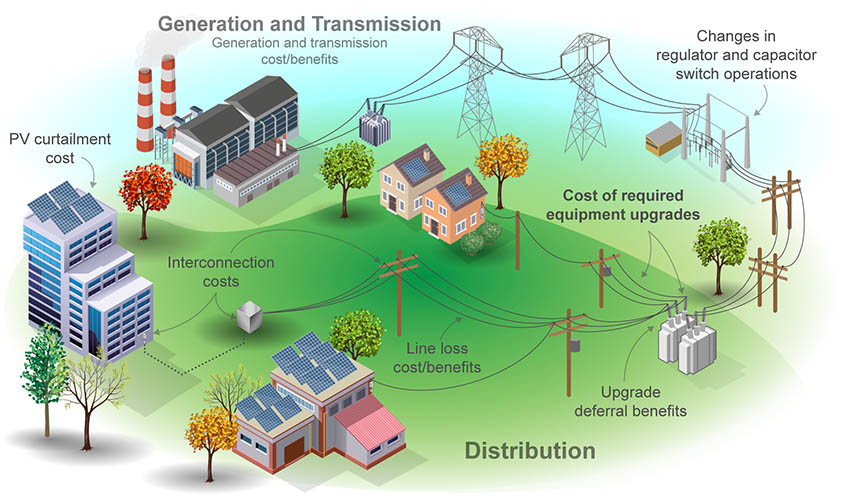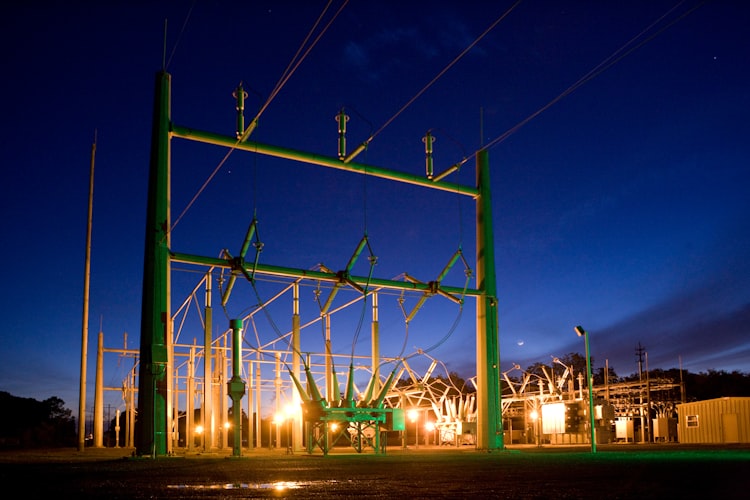Electricity is a viable source of energy because it can be easily transmitted over long distances via power cables and has a wide variety of uses. However, electricity is not the primary source of energy. It must be produced before it can be used. Once it is generated, it goes to power transformers and converts into the correct voltage. After that it is supplied to businesses and homes through a network of pylons and cables.
Electricity Generation
Generators convert kinetic energy into electricity. This can be done in two ways:
• Direct way – A turbine generates electricity by turning on the generator.
• Indirect way – When fuels (e.g. fossil fuels – natural gas, oil or coal) are used to simmer the water to produce steam which helps to push the blades of turbine and eventually turns the generator on. In the case of power plants that generate electricity in this way, energy is lost at each stage of this process to the environment, meaning only a third of the energy stored up in the fuel is transformed into electrical energy.

Electricity Transmission
Electricity is emitted to homes and businesses across the country through the National Grid. The National Grid transmits electricity at low power to reduce the energy lost by heat transfer during cable transmission. Step-up transformers in power stations generate the high voltages required to transmit power through the power lines of the national grid, expressed by Dry Type Transformer manufacturers. Since high voltages are very dangerous to use at home, step-down transformers are used locally to reduce the voltage to a safe level.
Power is transmitted from the power station to the consumer using long transmission cables. Power cables are made of aluminium as it is a good conductor of electricity and reducing the current in the cables reduces the power loss in the power transmission. When electricity transmits power over long distances, the cables are at a much higher voltage. The use of transformer aids to reduce losses during power transmission.
Functionality of Transformer
A transformer converts the voltage of an AC supply from high voltage to low-voltage (a step-down transformer) or from low-voltage to high-voltage (step-up transformer). The transformer is based on a very simple fact about electricity: when it is oscillated by a wire, it creates a magnetic field (invisible pattern of magnetism) or magnetic flux. The strength of a magnet (which bears the technical name of the magnetic flux density) is directly related to the magnitude of the electric current. So the larger the current, the stronger the magnetic field. Now there is another interesting thing about electricity. When a magnetic field oscillates around a wire, it creates an electric current in the wire. So, if we place the first coil wire next to the first and send an oscillating current to the first coil, it will create an electric current in the second coil. The current in the first coil is typically known as primary current and the current in the second coil is known as secondary current. Electric current transfers from one coil wire to another through an empty space, added by AC Transformer manufacturers. This is called electromagnetic induction because the current in the first coil causes current to flow in the second coil. By wrapping a soft iron around it, one can transmit electricity more efficiently.
To make a coil of wire, wrap the wire into round loops or (as physicists call them “twists”). If the second coil has the same turns as the first coil, the current in the second coil is the same as the first coil. If we have more or less turns on the second coil, secondary current and voltage can be made larger or smaller than the primary current and voltage.
The important thing to note is that this strategy only works if the current is fluctuating in some way. In other words, you must use a constant reverse current type called alternating current (AC) with the transformer. Transformers do not operate with direct current (DC), where constant current flows continuously in the same direction.
The step-up transformer raises the voltage before transmitting power through the power cables and with a small amount of current power is transmitted, commented by Control Transformer manufacturers. Hence the power loss is reduced. A step-down transformer decreases the voltage which ensures power is delivered at such a voltage that is appropriate to operate electrical appliances used by consumers.
The use of transformers in a power transmission means the use of alternating current (AC). This is because transformers can only step down and step up alternating current voltages.

Step-up transformers
By undoing the situation, we can build a step-up transformer that raises the low voltage to high. This time, we have more turns on the secondary coil than on the primary. This is still true:
Secondary voltage/Primary voltage = number of turns in the secondary/Number of turns in the primary
And
Secondary current/Primary current= number of turns in the primary/Number of turns in the secondary
In a step-up transformer, we use more turns in the secondary than in the primary to get a large secondary voltage and a small secondary current, verbalized by Variable Voltage Transformers manufacturers.
Step-down transformer
If the first coil has more curves than the second coil, the secondary voltage will be lower than the primary voltage. This is called a step-down transformer. If the second coil has half the turns of the first coil, the secondary voltage is half the magnitude of the primary voltage; if the second coil has a tenth of a turn, it has a tenth of the voltage. In general:
Secondary voltage/Primary voltage = number of turns in the secondary/ Number of turns in the primary Increases the magnitude of the current in the step-down transformer and changes the reverse current.
Secondary current/Primary current = number of turns in the primary/number of turns in the secondary
Therefore a step-down transformer with 100 coils in the primary and 10 coils in the secondary will reduce the voltage by a factor of 10, but multiply current by a factor of 10 at the same time. The current times the voltage is equal to the power in an electric, so the energy in the secondary coil is theoretically equal to the energy in the primary coil, pointed out by Rectifier Transformers manufacturers. In fact, there is some energy loss between the primary and secondary, as some magnetic flux leaks from the core and some energy is lost as the core warms up.


